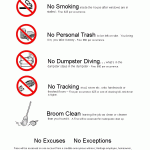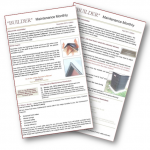Performance Standards: HBR article 17-1, 17-2 Click icon to view book 
Open seams – Open seams are not permitted.
Carpet loose from wall – Carpet will not be loose or separated from wall.
Note
Refer to your completed quote from the carpet supplier for your carpet selection information.
Homeowner Operation and Maintenance
Cleaning – You can add years to the life of your carpet with regular care. Carpet wears out because of foot traffic and dirt particles that get trampled deep into the pile beyond the suction of the vacuum. The dirt particles wear down the fibers like sandpaper and dull the carpet. The most important thing you can do to protect your carpet is to vacuum it frequently.
Vacuum twice each week lightly and once a week thoroughly. Heavy traffic areas may require more frequent cleaning. A light vacuuming is three passes; a thorough job may need seven passes. A vacuum cleaner with a beater-bar agitates the pile and is more effective in bringing dirt to the surface for easy removal.
Vacuuming high-traffic areas daily helps keep them clean and maintains the upright position of the nap. Wipe spills and clean stains immediately. For best results, blot or dab any spill or stain; avoid rubbing. Test stain removers on an out-of-the-way area of the carpet, such as in a closet, to check for any undesirable effects.
Have your carpet professionally cleaned regularly, usually after 18 months and then once a year after that.
Crushing – Furniture and traffic may crush a carpet’s pile fibers. Frequent vacuuming in high-traffic areas and glides or cups under heavy pieces of furniture can help prevent this. Rotating your furniture to change the traffic pattern in a room promotes more even wear. Some carpets resist matting and crushing because of their level of fiber, but this does not imply or guarantee that no matting or crushing will occur. Heavy traffic areas such as halls and stairways are more susceptible to wear and crushing. This is considered normal wear.
Fading – All carpets will slowly lose some color due to natural and artificial forces in the environment. You can delay this process by frequently removing soil with vacuuming, regularly changing air filters in heating and air conditioning systems, keeping humidity and room temperature from getting too high, and reducing sunlight exposure with window coverings.
Filtration – If interior doors are kept closed while the air conditioning or furnace is operating, air circulation from the closed room flows through the small space at the bottom of the door. This forces the air over the carpet fibers, which in turn act as a filter, catching particulate pollution. Over time, a noticeable discoloration may develop at door thresholds and return air vents. You can minimize this by changing your furnace filters regularly.
Rippling – With wall-to-wall carpeting, high humidity may cause rippling. If the carpet remains rippled after the humidity has left, have a professional re-stretch the carpeting.
Seams – Carpet usually comes in 12-foot widths, making seams necessary in most rooms. Visible seams are not a defect unless they have been improperly made or unless the material has a defect. The more dense and uniform the carpet texture, the more visible the seams will be. Carpet seams will be visible.
Carpet styles with low, tight naps result in the most visible seams. Seams are never more visible than when the carpet is first installed. Usually with time, use, and vacuuming the seams become less visible. You can see examples in our model homes of how carpet seams diminish after they have been vacuumed repeatedly and have experienced traffic.
Shedding – New carpeting, especially pile, sheds bits of fiber for a period of time. Eventually these loose fibers are removed by vacuuming.
Snags – Sharp-edged objects can grab or snag the carpet fiber. When this occurs, cut off the snag. If the snag is especially large, contact your carpet supplier or installer for assistance.
Sprouting – Occasionally you may find small tufts of fiber sprouting above carpet surface. Simply use scissors to cut off the sprout. Do not attempt to pull it, because other fibers will come out in the process.
Stains – No carpet is stain-proof. Although your carpet manufacturer designates your carpet as stain-resistant, some substances may still cause permanent staining. These include hair dyes, shoe polish, and paints. Other substances destroy or change the color of carpets, including bleaches, acne medications, drain cleaners, plant food, insecticides, and food or beverages with strongly colored natural dyes as found in some brands of mustard and herbal tea.
Refer to your carpet’s care and maintenance brochures for recommended cleaning procedures for your particular fiber. Pre-test any spot removal solution in an inconspicuous area before using it in a large area. Apply several drops of the solution, hold a white tissue on the area, and count to ten. Examine both tissue and carpet for dye transfer and check for carpet damage.
BUILDER Limited Warranty Guidelines
During your final walk through, we confirm that your carpet is in acceptable condition.
We will correct any open seams.
Stains or spots noted at this time will be remedied by cleaning, patching, or replacement. BUILDER is not responsible for dye lot variations if patching or replacements are made.
Carpet naturally lifting from the tack strips will be corrected one time during the warranty period.










